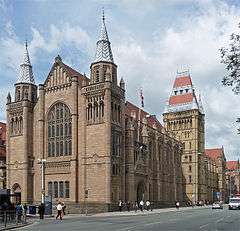University of Manchester Faculty of Engineering and Physical Sciences
The Faculty of Engineering and Physical Sciences (EPS) is one of the four faculties that comprise The University of Manchester. [1] [2] Established in October 2004, the faculty spans a range of "discipline areas" consisting of the Schools of Chemical Engineering and Analytical Science; Chemistry; Petroleum Engineering; Computer Science; Earth, Atmospheric and Environmental Science; Physics and Astronomy; Electrical & Electronic Engineering; Materials; Mathematics; and Mechanical, Aerospace and Civil Engineering.
The faculty includes most former UMIST departments, exceptions being Optometry and Neurosciences (now in the Faculty of Life Sciences), Manchester School of Management (now part of Manchester Business School MBS), and part of the Department of Computation which was split between the School of Computer Science and MBS. The duplicated departments of Physics, Chemistry and Mathematics were merged, and Materials Science was already a joint department. In terms of the total number of staff and student numbers the faculty is larger than the whole of UMIST, which was until 1993 the Faculty of Technology of the Victoria University of Manchester (paradoxically at the same time as being an independent institution).[3] The faculty offices are housed in the Sackville Street Building, the former UMIST Main Building.
The first Dean of the Faculty was Professor John Perkins FREng,[4] who joined the new university in 2004. Before appointment as Dean of EPS Professor Perkins was Principal of the Faculty of Engineering and Courtaulds Professor of Chemical Engineering at Imperial College London. He was succeeded in 2009 by Prof Colin Bailey, who was head of the School of Mechanical, Aerospace and Civil Engineering.[5] Bailey took over as acting dean on Perkins departure to become provost of the Masdar Institute of Science and Technology [6] in May 2009, and was confirmed as Dean in December the same year.
History
The University of Manchester has a long and distinguished record of achievement in science and engineering disciplines, and a history of breaking new ground. Rutherford began his work on splitting the atom at the University (and later received the Nobel Prize in 1908 for his work on radioactivity). The world's first stored-program computer, the Manchester Small-Scale Experimental Machine (nicknamed 'The Baby') came into being at the University, as did its successor, Manchester Mark 1.
The University of Manchester was the birthplace of Chemical Engineering.
The world's first steerable radio telescope at Jodrell Bank was built at the University by Bernard Lovell.
Since 1906, when former student Joseph Thompson won the Nobel Prize in Physics, the faculty and its antecedent institutions have produced more than 11 Nobel laureates in Physics out of the 25 awarded to staff or students of the University of Manchester as a whole. Most recently, Manchester physicists Andre Geim and Kostya Novoselov won the 2010 Nobel Prize in Physics for their pioneering work with graphene.[7]
The University's history is closely linked to Manchester's emergence as the world's first industrial city. Manchester businessmen and industrialists established the Mechanics' Institute to ensure that their workers could learn the basic principles of science. Similarly, John Owens, a Manchester textile merchant, left a bequest of £96,942 in 1851 for the purpose of founding a college for the education of males on non-sectarian lines. Owens College was established and granted a royal charter in 1880 to become England's first civic university, The Victoria University of Manchester.
Industrial Links
By 1905, the two institutions were a large and active force in the area, with the Mechanics' Institute, the forerunner of the modern UMIST, forming a Faculty of Technology and working alongside The Victoria University of Manchester. Although UMIST achieved independent university status in 1955, the two universities continued to work together, true to the visions of their pioneering industrialist founders, until they formally combined on 22 October 2004 to form a single university.
The Faculty of Engineering and Physical Sciences will be home to a new £64 million international research centre (2012), known as the BP International Centre for Advanced Materials (BP-ICAM). BP-ICAM will be modelled on a “hub and spoke” structure, with the ‘hub’ located at The University of Manchester and the “spokes” located at the University of Cambridge, Imperial College London, and the University of Illinois at Urbana-Champaign.[8]
Schools
The Faculty of Engineering and Physical Sciences comprises nine schools:
- School of Chemical Engineering and Analytical Sciences
- School of Chemistry
- School of Computer Science
- School of Earth, Atmospheric and Environmental Sciences
- School of Electrical and Electronic Engineering
- School of Materials
- School of Mathematics
- School of Mechanical, Aerospace and Civil Engineering
- School of Physics and Astronomy
References
- ↑ "Ordinances of The University of Manchester" (PDF). Retrieved 2008-09-14.
- ↑ "History of Faculty of Engineering and Physical Sciences". Retrieved 2008-09-14.
- ↑ "The Charter of The University of Manchester" (PDF). Retrieved 2008-09-14.
|first1=missing|last1=in Authors list (help) - ↑ "John Perkins Faculty of Engineering and Physical Sciences". Archived from the original on 2008-04-10. Retrieved 2008-09-14.
- ↑ "New Dean for EPS". Retrieved 2009-12-10.
- ↑ "Masdar Institute". Retrieved 2009-12-10.
- ↑ "Nobel Prize winners amongst our former and current staff and students". Retrieved 24 September 2012.
- ↑ "BP Pledges $100 Million to UK-Led Universities to Create Industry-Changing Materials". Archived from the original on August 15, 2012. Retrieved 24 September 2012.
